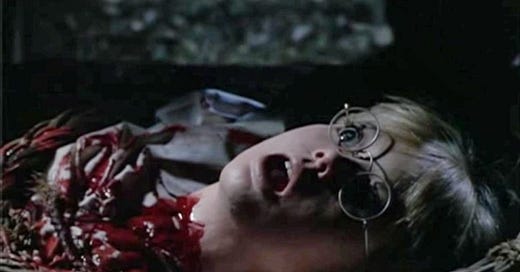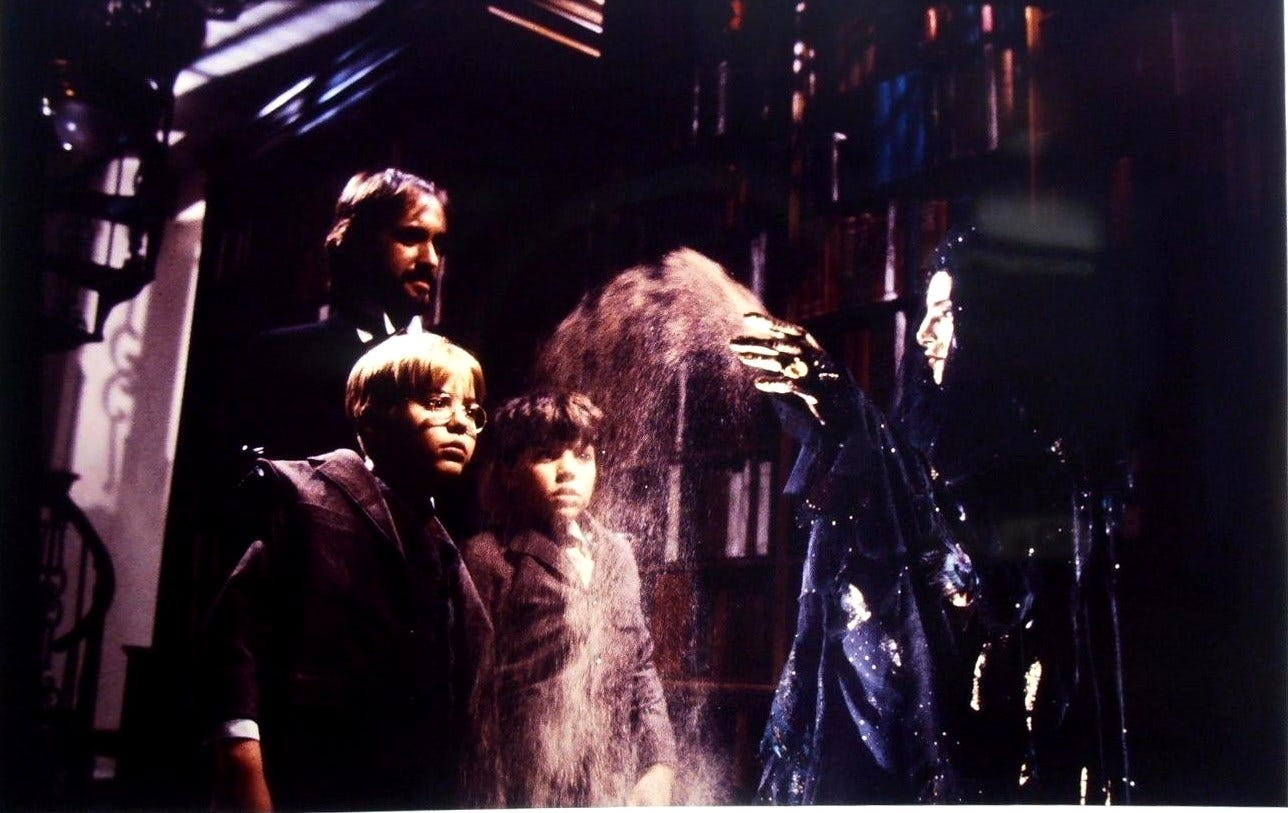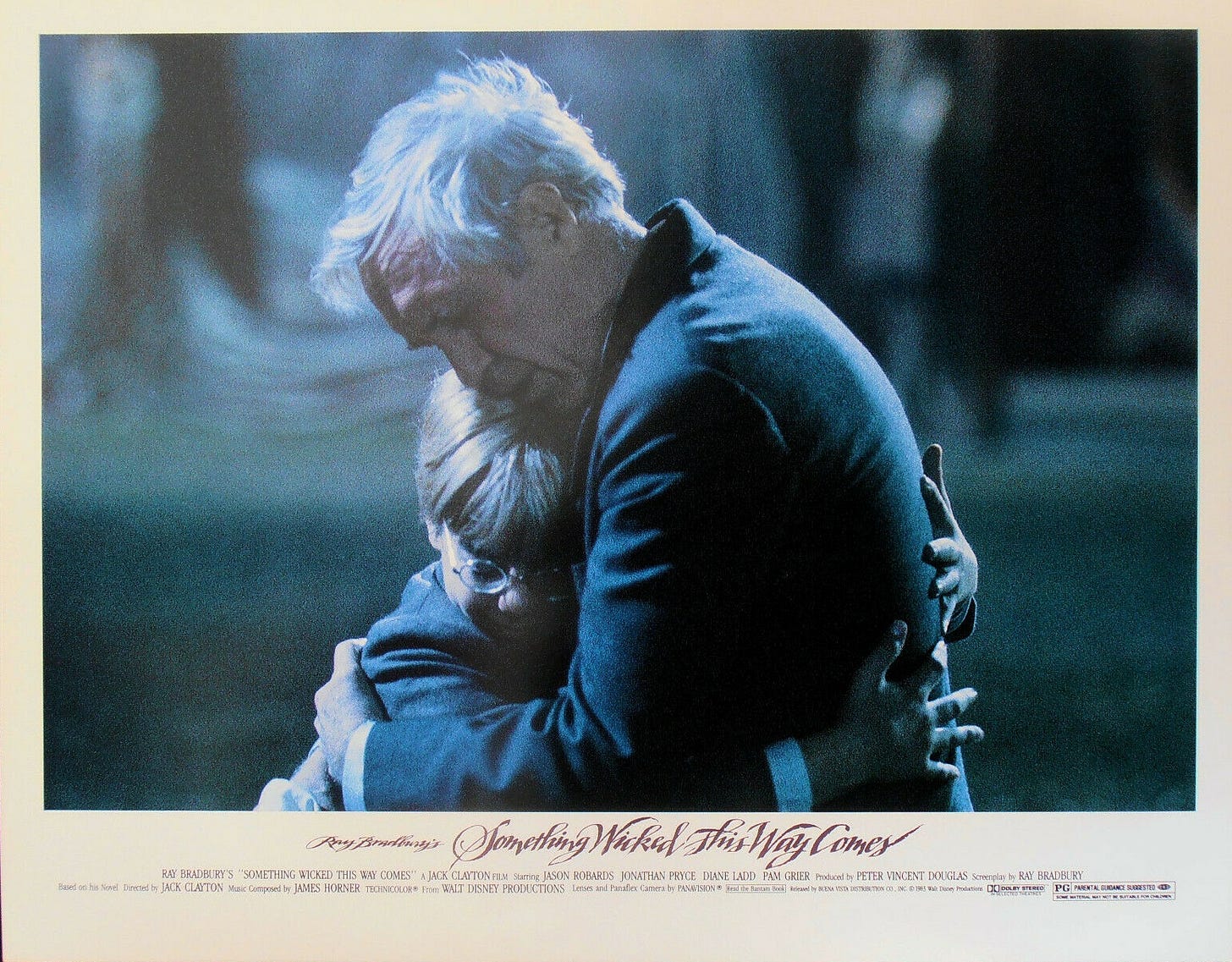Something Wicked This Way Comes (1983) (dir. Jack Clayton)
Far from perfect, Clayton's Wicked is still a film that has so many strengths going for it that I'm willing to look past the imperfections and simply go with it based on vibes and performance alone.
In hindsight, I probably shouldn’t have watched this film and Jack Clayton’s The Innocents back-to-back in one night recently because I ended up having nightmares as a result. Which makes sense given the fact that Ray Bradbury (along with Poe and King) was among my favorite writers growing up as a kid. I read this book at a young age in two nights (maybe because one of the protagonists was named Jim) and it captured my imagination in ways that went beyond mystery books and Choose Your Own Adventure ever could.
I binged on Jack Clayton for an upcoming podcast and became a fan of nearly everything (granted, I skipped his take on Gatsby simply because I never liked either the book or the adaptations). To be perfectly honest, my memory was fuzzy on his collaboration with Bradbury outside of a particular moment involving spiders that will forever stay with me. One spider, fine. Even one roach, fine. But when they turn into an army, out to attack, no no no no no, a thousand times no. Even as an adult, when they go after the kids in this film, I don’t go, “ohh that looks dated,” I’m still covering my eyes. That goes for a few moments here and I wanted to take time to elaborate further on why this film deserves more praise.
In the autumn of 1983, Disney released a film that stood in stark contrast to its usual family-friendly fare—a dark, atmospheric adaptation of Ray Bradbury's beloved 1962 novel, Something Wicked This Way Comes. Directed by British filmmaker Jack Clayton, this represents one of Disney's most ambitious and troubled productions, a work that has since an appreciation despite its commercial failure upon release. What makes this film fascinating is not just its place as an anomaly in Disney's catalog, but how it captures the essence of Bradbury's meditation on innocence, evil, and the passage from childhood to adulthood, all while bearing the marks of its difficult production history.
The journey of Something Wicked This Way Comes from page to screen was nearly as tumultuous as the story itself. Bradbury originally conceived the tale as a screenplay for his friend Gene Kelly in the 1950s, but when funding fell through, he expanded it into a novel. By the time Disney acquired the rights in the 1970s, Bradbury himself was commissioned to write the screenplay, and Jack Clayton was hired at Bradbury's recommendation, having previously worked together on the 1956 adaptation of Moby Dick directed by John Huston. Clayton produced.
What followed was a production plagued by creative differences and studio intervention. Clayton and Bradbury's visions for the film diverged significantly—Bradbury wanted to preserve the moral ambiguity of his novel, while Clayton aimed to make the material accessible to a wider audience. Kind of a different approach than the one Clayton took with his vision for The Taming of the Shrew with The Innocents. The initial cut of the film tested poorly with audiences, prompting Disney executives to take drastic measures. They invested an additional $4 million to reshoot scenes, add new special effects, and replace Georges Delerue's original score with a new one by James Horner.
The result was a film that bears the scars of its troubled production—a work that feels at times disjointed and sometimes unsure of itself. But there’s still a sense of foreboding dread and eerie uncertainty especially as things progress. Yet, paradoxically, the very tensions that contribute to the film's unique atmosphere, creates an experience that exists in a liminal space between childhood fantasy and adult horror, much like its protagonists. A circus is supposed to be fun for kids, but it becomes a force of evil fairly quickly. Curiosity brings the creeps.
Clayton's film is set in the fictional Green Town, Illinois (a stand-in for Bradbury's hometown of Waukegan), a quintessential small American town circa 1920. The film's opening establishes a warm, nostalgic atmosphere with autumn-hued cinematography by Stephen H. Burum that captures the golden light of fall and the innocence of small-town America. This Norman Rockwell-esque setting serves as the perfect canvas for the darkness that is to come.
The arrival of Cooger and Dark's Pandemonium Shadow Show is heralded by an ominous train that appears in the dead of night, billowing steam and piercing the darkness with its headlight—a direct reference to the Lumière Brothers' L'Arrivée d'un train en gare de La Ciotat one of cinema's earliest and most iconic moments of course. This visual callback establishes a connection between the carnival's illusions and the illusory nature of cinema itself, a theme that recurs throughout the film. Not to mention the corruption of innocence (something Clayton has touched on many times) and the impending march of death that lurks around the corner in the form of Mr. Dark.
The carnival itself is a masterpiece of production design, with its weathered tents, mysterious attractions, and the two centerpieces that drive the narrative: the Mirror Maze and the carousel. The Mirror Maze, with its endless reflections, serves as a physical manifestation of the characters' inner desires and fears, while the carousel, which can age its riders forward or backward depending on its direction, embodies the film's central preoccupation with time and aging.
Clayton's direction excels in creating a sense of mounting dread as the carnival infiltrates the town. Particularly effective is the parade sequence, where Mr. Dark marches down the main street with his carnival performers, searching for the boys who have discovered his secret. The scene is shot with a deliberate, almost funeral pace, the camera lingering on the faces of the townspeople as they are drawn to the spectacle despite themselves.
At the heart of the film are its three central performances: the reliable Jason Robards as Charles Halloway, an aging librarian (yay!) and father to Will; a superb Jonathan Pryce as the sinister Mr. Dark; and Pam Grier as the enigmatic Dust Witch (who doesn’t get nearly enough screen time to shine).
Robards brings a world-weary gravitas to Charles Halloway, a man who regrets the lateness of his fatherhood and feels he has failed his son. His performance is marked by a quiet stoicism that occasionally gives way to moments of profound emotion, particularly in his confrontation with Mr. Dark in the library. While Robards was 61 at the time of filming (older than the 54-year-old character in the novel), his performance captures the essential conflict of a man wrestling with his own mortality and the fear that he cannot protect his son from the world's evils.
Jonathan Pryce's portrayal of Mr. Dark is the film's standout element—a performance of controlled malevolence that avoids the pitfalls of mustache-twirling villainy. He’s subtle until he gets fierce and nasty confronting Charles by tearing out pages out of a book (oddly missing a couple of numbers possibly due to sloppy editing). Pryce imbues Dark with a seductive charm that makes his evil all the more insidious. His scenes with Robards crackle with tension, particularly their confrontation in the library, where Dark tempts Halloway with youth while tearing pages from books that glow with each rejected offer. He’s a brooding, nasty villain and Pryce relishes every moment without once hamming it up.
Pam Grier's Dust Witch is a more enigmatic presence than anything that stays with you, her performance relying more on physicality and presence than dialogue. She’s cloaked and mysterious until her face alters. I imagine she was told to dial things down and not externalize but sadly, she’s so damn good at being expressive that it’s sad to watch her be more in the background throughout. Still, with her veiled beauty and graceful movements, she embodies the carnival's seductive danger. Though her character is somewhat underdeveloped compared to the novel, Grier does her best as always, creating a memorable antagonist whose silent menace lingers in the viewer's mind.
The film's young leads, Vidal Peterson as Will Halloway and Shawn Carson as Jim Nightshade, deliver performances that, while occasionally mechanical, capture the essence of their characters—Will's caution and moral certainty contrasted with Jim's recklessness and fascination with the forbidden. Their performances improve as the film progresses, particularly in the more intense later scenes. I can certainly relate to moments of their behavior when I was around their age - curious but cautious.
Something Wicked This Way Comes is rich in thematic depth and layers, exploring the persistent nature of evil, the passage from innocence to experience, and the human relationship with time and mortality. You can’t stop what’s coming and that’s what the carnival and Mr. Dark ultimately represent. Watching this now, there’s no denying the impact and influence that Bradbury’s work here had on Stephen King especially with works like Needful Things or Storm of the Century.
All of the lurking evil stirs as a manifestation of temptation, offering the townspeople their deepest desires while concealing the terrible price they must pay. This Faustian bargain is at the core of the film's moral universe—the idea that getting what you want often comes at the cost of what you need. Mr. Dark's carnival preys on the dissatisfaction that lurks beneath the surface of even the most idyllic community, exploiting the gap between people's outward contentment and their inner longings.
The film also explores the relationship between fathers and sons, particularly through Charles Halloway's character arc. That element alone that always gets to me on an emotional level. Time and aging are central preoccupations of the film, embodied most literally in the carousel that can add or subtract years from its riders. The fear of growing old haunts Charles Halloway, while Jim Nightshade is impatient to grow up, making both vulnerable to Mr. Dark's manipulations. The film suggests that both perspectives are flawed—that wisdom lies in accepting the natural progression of time rather than trying to accelerate or reverse it.
The lightning and storm imagery (more Jim-nip) that recurs throughout the film serves as a powerful symbol of both destruction and illumination. Tom Fury's lightning rod, which ultimately saves the boys from the Dust Witch's attack, represents protection against the forces of darkness. The climactic lightning strike that destroys the carousel suggests that sometimes the very forces we fear can be turned against evil.
The film's visual style is a study in contrasts—the warm, golden hues of Green Town set against the shadowy, blue-tinted world of the carnival. Stephen H. Burum's cinematography creates a dreamlike quality that blurs the line between reality and nightmare, particularly in scenes like the Dust Witch's balloon ride (which was cut from the final film) and the Mirror Maze sequence. There’s one unfortunate trope that is hard to ignore, given Peter Dinklage’s objection to the use of little people in Living in Oblivion. Again, this was a different time and certainly not the only film to utilize those of a smaller stature for purposes of being creepy/weird. After all, I’m sure many of them worked in carnivals.
Watching this film now after driving to The House on the Rock in Wisconsin last summer certainly made me revisit certain images from that incredible experience (another that gave me nightmares and surreal dreams the following night). Something about a carousel alone is enough to get under my skin (used beautifully here despite an underbaked climax).
The special effects, while dated by modern standards, retain a tactile quality that contributes to the film's unsettling atmosphere. Particularly effective is the aging sequence on the carousel, where Mr. Cooger is transformed from an adult to a child through a combination of practical effects and optical illusions. The spider attack scene, added in reshoots, remains genuinely disturbing, though it feels somewhat disconnected from the rest of the film.
James Horner's score, which replaced Georges Delerue's original composition, effectively balances whimsy and menace. His main theme captures the wonder and terror of childhood, while his carnival music has an appropriately off-kilter quality that suggests something not quite right lurking beneath the surface. While Delerue's unused score (which can be found online) is more overtly ominous, Horner's work better serves the film's balance of fantasy and horror.
For Bradbury fans, the film remains a flawed but fascinating adaptation of one of his most beloved works. One that I wholeheartedly embrace as a classic that I plan to go back to time and time again. While it doesn't capture every aspect of the novel to a fault, it preserves its essential spirit and many of its most memorable moments. Bradbury himself, despite his frustrations with the production, acknowledged it as "not a great film, no, but a decently nice one."
Jack Clayton's Something Wicked This Way Comes stands as a stylish entry in the canon of American horror cinema—a film that dares to take children's fears seriously and treats the transition from childhood to adulthood as a journey fraught with both wonder and terror. Its troubled production history is reflected in its sometimes-uneven tone and pacing, yet these very flaws contribute to its dreamlike quality, creating a work that feels as if it exists in the liminal space between waking and sleeping.
The film's enduring appeal lies in its recognition that the most frightening monsters are not external threats but the shadows on the wall or the skeletons in a closet—our unfulfilled desires, our regrets, and our fears of what we might become. We can’t stay young forever. What will ultimately corrupt us? In Mr. Dark's carnival, we see not just a collection of supernatural horrors but a mirror reflecting our own darkest impulses. Stranger things, indeed!
I guess watching it now in 2025, I couldn’t help but recontextualize the carnival as being representative of the current evils we’re dealing with in this country with Mr. Dark standing in place for Idiot Trump. Obviously, that’s projection on my part and unintended, but alas, these are the sad, scary times we’re living in. It does after all, feel like an invasion of spiders are descending upon the innocent lately. Clayton’s film is far from a masterpiece for reasons stated earlier but his collaboration with Bradbury still sits well and holds up beautifully.
As a carnival train disappears into the night at the film's conclusion, we are left with the unsettling sense that it has not been defeated but merely driven away temporarily—that somewhere, in some other small town, the calliope is playing, and Mr. Dark is once again offering to fulfill dreams for a price that seems small until it's too late. Or an alternate manifestation is inevitably about to seek and destroy the good in the world.
In this way, Something Wicked This Way Comes reminds us that the battle between good and evil is never truly won but must be fought anew by each generation as it confronts the shadows that lie within and without. There’s no rest for the wicked but that doesn’t mean we should stay asleep in fear of them either.









I really loved this movie when it came out in 1983. It has been very poorly treated on home video. It would be great if Disney would finally release a Blu Ray with bonus features. Jonathan Pryce is terrific as MR. Dark.